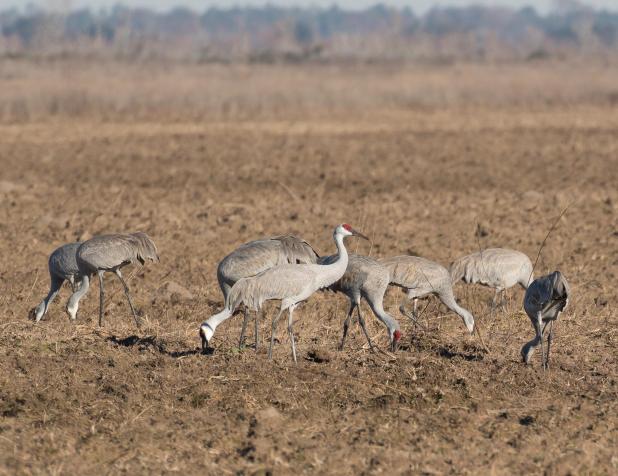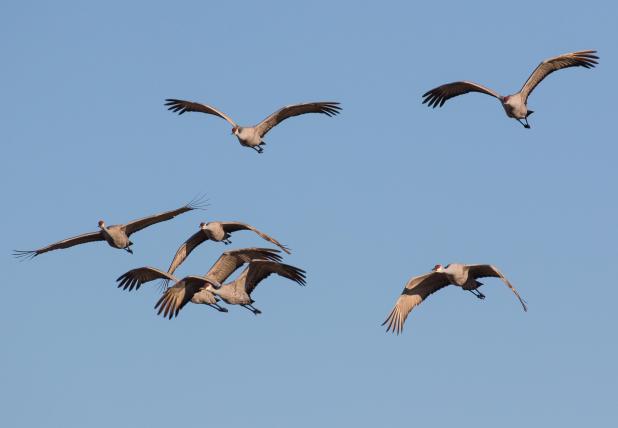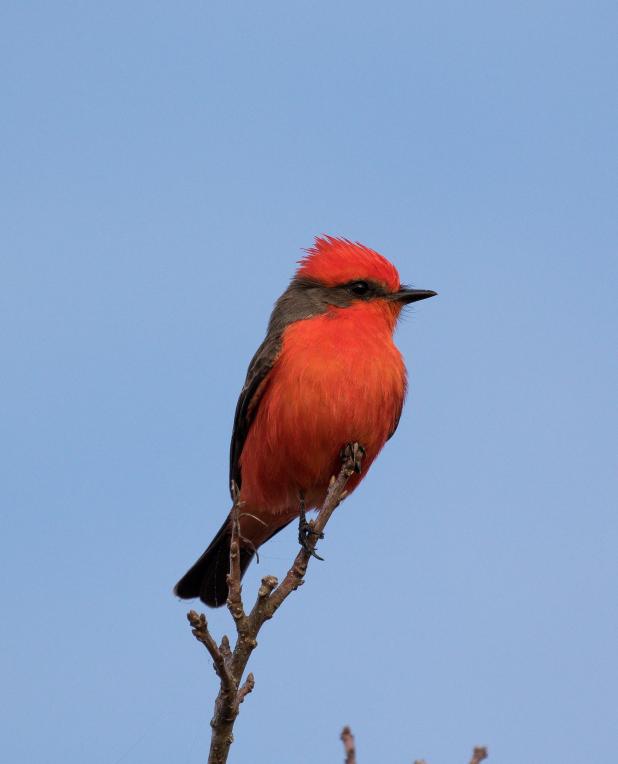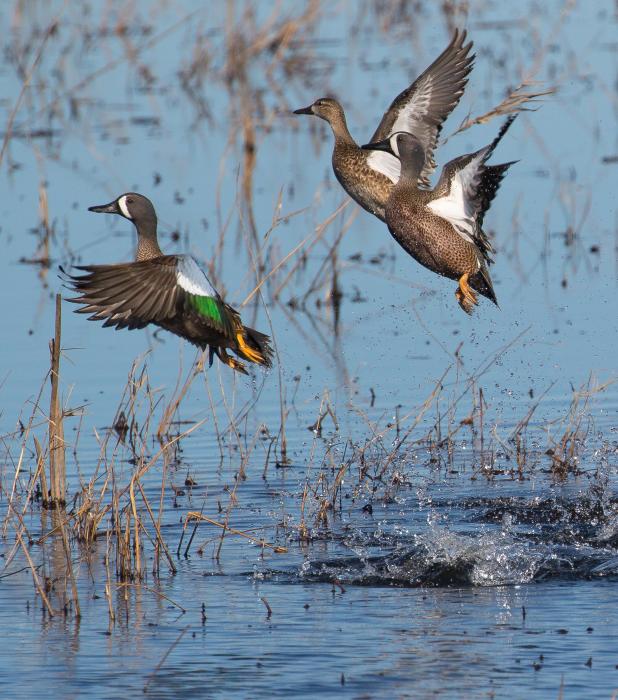
Sandhill cranes graze in a field along Pine Prairie Road south of Lake Charles.
The Review/John K. Flores

Sandhill cranes in flight

A Vermillion flycatcher observed on Lacassine NWR.

Blueiwinged teal taking off in a pond at Lacassine NWR.
John K. Flores: Arrival of cold weather brings plenty of winter birds to see
A few weeks back, when the calendar flipped from 2023 to 2024, I made my first winter birding trip to southwest Louisiana in pursuit of Sandhill cranes. Physically, the big birds stand close to four-feet tall and have a wingspan of roughly six-feet.
They’re also a pretty bird. Overall, an adult crane’s colors are a mixture of light grays and earthy browns, with soft brushstrokes of white in its feathers for accent. Pulling it all together is a ruby crown of feathers on top of its head that glisten when kissed by the rays of the sun.
A Sandhill crane’s trumpet-like call is unmistakable and one you’ll enjoy and never forget. When several of these birds gather and trumpet in unison, the enchanting sound becomes like a wild choir. It’s something everyone should experience.
Sandhill cranes are migratory birds. If you don’t catch a glimpse of Sandhill cranes during the winter here in Louisiana, you’ll have to travel to the northern states and far reaches of Canada duringthe spring and summer breeding months to see them.
Clint Ward, a renowned fiddle player from south of Lake Charles, knew I was into birding me on social media saying, “Hey, you busy this week? Do you want to come see some Sandhill cranes up close you might be able to photograph?”
Jumping at the chance, it was a 4:30 A.M. rise out of bed to make the nearly 3 hour journey to Ward’s place.
When I arrived, Ward was ready and we jumped in his truck not to lose any more time. We slowly drove past the property on Corbina Road that he had initially contacted me about saying, “The birds were so close to the road you can’t miss them with your camera.”
Sure enough, a few Sandhill were there, but they were way to the back of the field and their location was directly into the sun. “Bummer,” I thought. However, not to worry.
Ward said, “Let me check with a buddy. Between him and me we know a few other farms where they’ve been hanging out.”
Calling his friend on his cellphone we were soon off to check out a couple other potential locations. We drove a few dusty back roads that ran parallel with LA27 before crossing the highway, to take Pine Pasture Road east. We found a large flock of several hundred Sandhill cranes digging and rooting in a field with their stiletto beaks right where his buddy said they would be. Whatever was in that soil, they were digging it out. We pulled over to the edge of the road and I rolled down my passenger side window and snapped a bunch of pictures of them both in flight and feeding. With mission accomplished on the winter Sandhill crane birding excursion, I set my sights towards home, but then realized if I took LA14 east I would drive right past, Lacassine National Wildlife Refuge. The word out on the birder-streets was Lacassine was teeming with ducks this year.
Lacassine has a 2.8 mile nature drive that has you literally looking at thousands upon thousands of ducks.
The nature drive didn’t disappoint. Besides black-bellied whistling ducks, I saw blue and green winged teal, plenty of northern shovelers, gadwall, pintails, widgeon, ring-necked ducks, and scaup.
Plus, one super-photogenic juvenile hooded merganser.
Whenever a hawk would dive down towards the ducks, they would rise in a black cloud. The sound was like a heavy storm gust that rushes at you. In short, the numbers and sound were just awe inspiring.
To top things off, I got to see a rare winter visitor from the west along the nature drive. A vermilion flycatcher. He was a handsome fellow to say the least and was used to people with cameras, because he readily posed for several pictures.
Local guys like Terrebonne Bird Club President, Paul Schaub, love winter birding and have been out the past several weeks doing the same thing I was.
Schaub said, “I love the sparrows that come in during the winter. On any given day you might get 7 to 10 different species. And, even though we lose some of our species as they migrate, we get other birds that end up here in south Louisiana to spend the winter here.
“And, of course there’s the majestic bald eagles who are very plentiful in our local area here in St. Mary Parish,” Schaub continued. “Our Terrebonne bird club takes up to 4 trips during the fall and winter. There’s also the Audubon Christmas bird count that’s done every year.”
One of my best shots along the Lacassine nature drive was of blue winged teal that flushed from a nearby pond. Their color was in full breeding plumage and when they rose off the sun really made their feathers pop.
Southwest Louisiana is also a great place to check out the beaches for various shorebirds, gulls, and wading birds like reddish egrets. The reddish egret has a beautiful lion-like feathery mane on its head and neck. It’s a wonderful bird to observe chasing food in the surf, as it uses its wings to shadow the water while it grabs its prey.
Another unique thing about reddish egrets is they come in two colors. They have the gray body and reddish mane color phase and a completely white morph color.
But, if you’re unable to get out, sometimes you only have to go as far as a backyard feeder to see winter birds, particularly with the frigid weather we’ve been having. Winter birds you may see at your feeder are American goldfinches, house finches, and pine siskins, as well as doves, sparrows, and
pushy grackles that can be quite raucous.
Whether you like to get out and travel to do a little nature viewing or stay just stay at home bundled up when it’s cold, winter can be some fun months to look at birds you might not otherwise regularly see.
